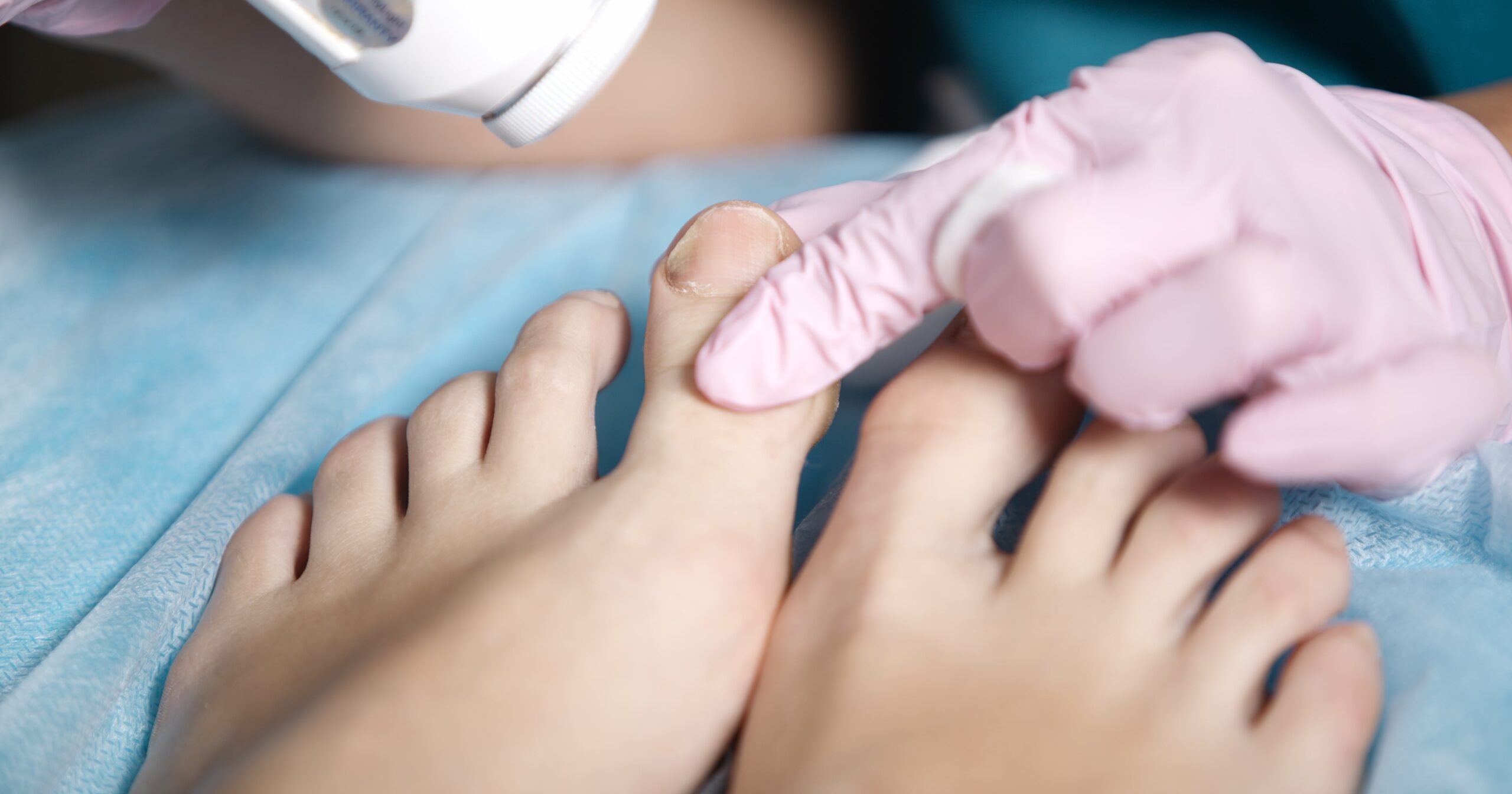Image Source: Getty / danr13
We’ll just come right out and say it: some of us have been guilty of leaving our nail polish on far too long. More often than not, when that polish is then removed, we discover that what’s hiding underneath isn’t always a pretty sight. If you, too, can relate, then you’re probably familiar with the sheer panic that’s often accompanied by seeing a discolored toenail (or a few).
There are a few potential reasons that could be causing discoloration, and not all of them look the same. There might be white spots on the nail, for example, or dark spots hiding underneath or near the cuticle area, as well as yellowing that could indicate a possible infection. Still, there’s a difference between nail fungus and nail discoloration, so if you’re noticing any major changes on your own hands or feet, it’s probably time to learn the difference (and make an appointment with your dermatologist just to be safe).
To further help differentiate between the two, we asked an expert to break down everything you should know below.
Experts Featured in This Article
Jennifer Weiss, PA-C, is a board-certified cosmetic and surgical dermatology physician assistant at Marmur Medical.
The Difference Between Nail Fungus and Nail Discoloration
“Nail fungus is a common infection of the nails,” dermatology physician assistant Jennifer Weiss says. “We all have fungus naturally on our nails and bodies in general, but sometimes there is an overgrowth of that fungus, and that is when you may see a noticeable change in the appearance or color of the nails.” It should be noted, however, that not all discoloration of the nails is due to fungus.
Nail discoloration, on the other hand, refers to any marks that do not appear translucent or uniform in color to the rest of your nail. In this instance, they “may look yellow, brown, black, or even green,” Weiss says. These can pop up anywhere on the nail, either in spots or vertically along the nail.
What Causes Nail Fungus and Discoloration?
Like many fungal infections, there are a few way to develop a nail fungus. Chief among them? Excess moisture. “Fungus thrives in warm, moist environments, so nail fungus can be caused by excessive sweating or walking barefoot in a warm, moist environment like a pool,” Weiss says. “You can also catch it by having direct skin-to-skin contact with someone who already has a fungal infection.”
As for the causes of nail discoloration, there could be a host of reasons wholly unrelated to a fungal infection that causes the issue. “A brown or black streak on a nail is known as melanonychia,” Weiss says. “This should always be diagnosed by a certified dermatology provider as you want to make sure to rule out something more serious such as a melanoma. Melanonychia is benign and can be caused by genetics, trauma to the area, medication use, or pregnancy.” Black discoloration of the nail can also be caused by dried blood due to some type of trauma – also known as a subungual hematoma – so if you’re not sure what could have caused a black mark on your nail, it’s best to err on the side of caution and pay a visit to a medical provider.
“Nails that appear green are most often caused by a bacteria called Pseudomonas aeruginosa,” Weiss adds. Prolonged exposure to water or soaps and detergents can put someone at a higher risk of developing this bacterial infection.
How to Tell the Difference Between Nail Fungus and Nail Discoloration
While Weiss doesn’t recommend trying to self-diagnose at home, there are some tell-tale characteristics of a nail fungus that can make it easier to spot. “Nail fungus typically appears as yellow, thickened nails,” she says. If you’re still not sure whether your nail fits the bill, contact your dermatologist for further testing. In some instances, that may mean getting the nail biopsied and tested to be sure.
What Nail Fungus Might Look Like
Nail fungus can show up in different forms, but a thickened, yellow nail is typically a key characteristic of nail fungus.
What Nail Discoloration Might Look Like: Subungual Hematoma
How to Treat Nail Fungus and Discoloration
As to be expected with any medical condition, many treatment options for nail fungus include prescription-strength medication. “These include prescription antifungal lacquers or, for more severe cases, an antifungal pill,” Weiss says. “The pill involves a three-month course and typically requires blood-work testing initially and halfway through the course. When using the lacquer, it is recommended that it be applied to the affected nail or nails for a whole year.”
There is also an at-home remedy that has been proven to help with treating nail funguses as well: Vicks VapoRub. “The ingredients of thymol, menthol, camphor, and oil of eucalyptus in clinical studies have been shown to be effective,” Weiss says.
For nail discoloration, treatment depends on the cause. For example, Weiss says it is best to leave the benign melanonychia alone, while “melanoma, on the other hand, needs to be addressed promptly with surgery.” If it is a normal cause of an injury that bled underneath the nail, the best course of action in that case is to let the dried blood underneath a nail grow out on its own.
However, treatment for pseudomonas, the last typical case of non-fungal-related discoloration, is a bit more intensive. “[This treatment] involves taking an oral antibiotic that is susceptible to pseudomonas,” Weiss says. “You can also try vinegar soaks at home, which involves one-part vinegar and four-parts water, and soak the affected nail or nails in for 10 minutes, twice daily until the infection is resolved.”
How to Prevent Nail Fungus and Discoloration
“Prevent nail fungus or discoloration from happening by not walking barefoot in warm, moist environments,” she says. “It is recommended to keep your feet clean and dry, wash them daily with soap and water – taking special care to clean in between your toes – and then drying them thoroughly after.” Additional tips include keeping your nails short and making sure to sanitize your nail clipper before use.
As always, be sure to check with your doctor should any concerning discoloration arise.
Ariel Baker is the associate editor for PS Beauty. Her areas of expertise include celebrity news, beauty trends, and product reviews. She has additional bylines with Essence and Forbes Vetted.




